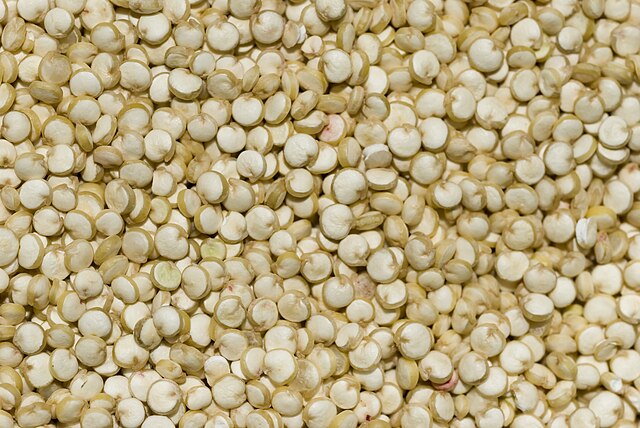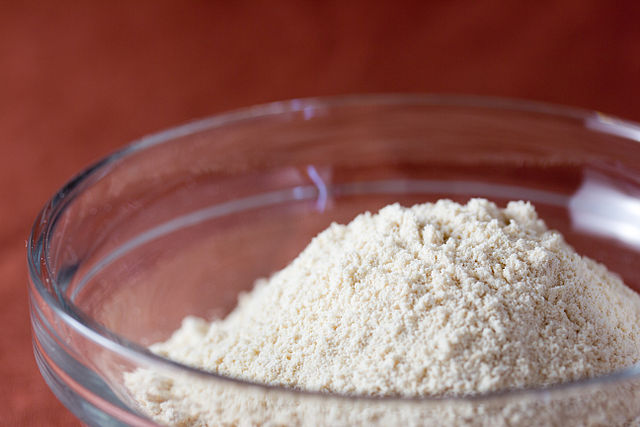Quinoa vs. Soy Flour
Nutrition comparison of Cooked Quinoa and Soy Flour
Ever wonder how your favorite foods stack up against each other in terms of nutrition?
We compared the nutritional contents of
cooked
quinoa
versus
soy flour
(100g each)
below using 2020 USDA and NIH data[1].
For a quick recap of significant nutrients and differences in quinoa and soy flour:
- Both quinoa and soy flour are high in calories and dietary fiber.
- Quinoa has 4.5 times less saturated fat than soy flour.
- Quinoa has 9.7 times less sugar than soy flour.
- Soy flour has more beta-carotene than quinoa, however, quinoa contains more lutein + zeaxanthin than soy flour.
- Soy flour has more thiamin, riboflavin, niacin, pantothenic acid, Vitamin B6 and folate.
- Soy flour is an excellent source of calcium, iron, potassium and protein.
USDA sources for nutritional information: Quinoa (Quinoa, cooked) and Soy Flour (Soy flour, low-fat) . Have a correction or suggestions? Shoot us an email.
Calories and Carbs
calories
Both quinoa and soy flour are high in calories. Soy flour has 210% more calories than quinoa - quinoa has 120 calories per 100 grams and soy flour has 372 calories.
For macronutrient ratios, quinoa is much lighter in protein, much heavier in carbs and lighter in fat compared to soy flour per calorie. Quinoa has a macronutrient ratio of 15:71:15 and for soy flour, 50:31:20 for protein, carbohydrates and fat from calories.
Macro Ratios from Calories:
| Quinoa | Soy Flour | |
|---|---|---|
| Protein | 15% | 50% |
| Carbohydrates | 71% | 31% |
| Fat | 15% | 20% |
| Alcohol | ~ | ~ |
carbohydrates
Soy flour is high in carbohydrates and quinoa has 30% less carbohydrates than soy flour - quinoa has 21.3g of total carbs per 100 grams and soy flour has 30.6g of carbohydrates.
The carbs in quinoa are made of 83% starch, 13% dietary fiber and 4% sugar, whereas the carbs in soy flour comprise of 52% dietary fiber, 31% sugar and 17% starch.
dietary fiber
Both quinoa and soy flour are high in dietary fiber. Soy flour has 471% more dietary fiber than quinoa - quinoa has 2.8g of dietary fiber per 100 grams and soy flour has 16g of dietary fiber.
sugar
Quinoa has 9.7 times less sugar than soy flour - quinoa has 0.87g of sugar per 100 grams and soy flour has 9.3g of sugar.
Protein
protein
Soy flour is an excellent source of protein and it has 10 times more protein than quinoa - quinoa has 4.4g of protein per 100 grams and soy flour has 49.8g of protein.
Fat
saturated fat
Quinoa has 4.5 times less saturated fat than soy flour - quinoa has 0.23g of saturated fat per 100 grams and soy flour has 1.3g of saturated fat.
Vitamins
Vitamin A
Soy flour and quinoa contain similar amounts of Vitamin A - soy flour has 2ug of Vitamin A per 100 grams and quinoa does not contain significant amounts.
Vitamin E
Quinoa and soy flour contain similar amounts of Vitamin E - quinoa has 0.63mg of Vitamin E per 100 grams and soy flour has 0.55mg of Vitamin E.
Vitamin K
Soy flour and quinoa contain similar amounts of Vitamin K - soy flour has 3.9ug of Vitamin K per 100 grams and quinoa does not contain significant amounts.
The B Vitamins
Soy flour has more thiamin, riboflavin, niacin, pantothenic acid, Vitamin B6 and folate.
| Quinoa | Soy Flour | |
|---|---|---|
| Thiamin | 0.107 MG | 1.088 MG |
| Riboflavin | 0.11 MG | 0.28 MG |
| Niacin | 0.412 MG | 2.95 MG |
| Pantothenic acid | ~ | 1.55 MG |
| Vitamin B6 | 0.123 MG | 1.05 MG |
| Folate | 42 UG | 289 UG |
Minerals
calcium
Soy flour is an excellent source of calcium and it has 15 times more calcium than quinoa - quinoa has 17mg of calcium per 100 grams and soy flour has 285mg of calcium.
iron
Soy flour is an excellent source of iron and it has 450% more iron than quinoa - quinoa has 1.5mg of iron per 100 grams and soy flour has 8.2mg of iron.
potassium
Soy flour is an excellent source of potassium and it has 11 times more potassium than quinoa - quinoa has 172mg of potassium per 100 grams and soy flour has 2090mg of potassium.
Antioxidants and Phytonutrients
carotenoids
Carotenoids are micronutrients commonly found in plants and some animal products. An example is beta-carotene, the notable carotenoid which is a popular source of Vitamin A.[4][5]
For specific types of carotenoids, soy flour has more beta-carotene than quinoa per 100 grams, however, quinoa contains more lutein + zeaxanthin than soy flour per 100 grams.
| Quinoa | Soy Flour | |
|---|---|---|
| beta-carotene | 3 UG | 24 UG |
| lutein + zeaxanthin | 53 UG | ~ |
Omega-3 and Omega-6
omega 3s
For omega-3 fatty acids, soy flour has more alpha linoleic acid (ALA) than quinoa per 100 grams, however, quinoa contains more dha than soy flour per 100 grams.
| Quinoa | Soy Flour | |
|---|---|---|
| alpha linoleic acid | 0.085 G | 0.555 G |
| DHA | 0.015 G | ~ |
| Total | 0.1 G | 0.555 G |
omega 6s
Comparing omega-6 fatty acids, soy flour has more linoleic acid than quinoa per 100 grams.
| Quinoa | Soy Flour | |
|---|---|---|
| linoleic acid | 0.974 G | 3.66 G |
| other omega 6 | ~ | 0.025 G |
| Total | 0.974 G | 3.685 G |
Customize your serving size
The comparison below is by common portions, e.g. cups, packages. You can also see a more concrete comparison by weight at equal weight (by grams) comparison.
Cooked Quinoa g
()
|
Daily Values (%) |
Soy Flour g
()
|
|||||
|---|---|---|---|---|---|---|---|
| KCAL % |
|
5% | calories | 5% |
|
KCAL % | |
| G % |
|
5% | carbohydrates | 5% |
|
G % | |
| G % |
|
5% | dietary fiber | 5% |
|
G % | |
| G | 5% | sugar | 5% | G | |||
| G % |
|
5% | total fat | 5% |
|
G % | |
| G % |
|
5% | saturated fat | 5% |
|
G % | |
| G | 5% | monounsaturated fat | 5% | G | |||
| G | 5% | polyunsaturated fat | 5% | G | |||
| G | 5% | trans fat | 5% | G | |||
| MG | 5% | cholesterol | 5% | MG | |||
| MG % |
|
5% | sodium | 5% |
|
MG % | |
| 5% | Vitamins and Minerals | 5% | |||||
| UG % |
|
5% | Vitamin A | 5% |
|
UG % | |
| MG % |
|
5% | Vitamin C | 5% |
|
MG % | |
| IU % |
|
5% | Vitamin D | 5% |
|
IU % | |
| MG % |
|
5% | calcium | 5% |
|
MG % | |
| MG % |
|
5% | iron | 5% |
|
MG % | |
| MG % |
|
5% | magnesium | 5% |
|
MG % | |
| MG % |
|
5% | potassium | 5% |
|
MG % | |
| MG % |
|
5% | thiamin (Vit B1) | 5% |
|
MG % | |
| MG % |
|
5% | riboflavin (Vit B2) | 5% |
|
MG % | |
| MG % |
|
5% | niacin (Vit B3) | 5% |
|
MG % | |
| MG % |
|
5% | Vitamin B6 | 5% |
|
MG % | |
| MG % |
|
5% | pantothenic acid (Vit B5) | 5% |
|
MG % | |
| UG % |
|
5% | folate (Vit B9) | 5% |
|
UG % | |
| UG % |
|
5% | Vitamin B12 | 5% |
|
UG % | |
| MG % |
|
5% | Vitamin E | 5% |
|
MG % | |
| UG % |
|
5% | Vitamin K | 5% |
|
UG % | |
| G % |
|
5% | protein | 5% |
|
G % | |
| UG % |
|
5% | biotin (Vit B7) | 5% |
|
UG % | |
| MG % |
|
5% | choline | 5% |
|
MG % | |
| MG % |
|
5% | chlorine | 5% |
|
MG % | |
| UG % |
|
5% | chromium | 5% |
|
UG % | |
| MG % |
|
5% | copper | 5% |
|
MG % | |
| UG % |
|
5% | fluoride | 5% |
|
UG % | |
| UG % |
|
5% | iodine | 5% |
|
UG % | |
| MG % |
|
5% | manganese | 5% |
|
MG % | |
| UG % |
|
5% | molybdenum | 5% |
|
UG % | |
| MG % |
|
5% | phosphorus | 5% |
|
MG % | |
| UG % |
|
5% | selenium | 5% |
|
UG % | |
| MG % |
|
5% | zinc | 5% |
|
MG % | |
| G | 5% | Water | 5% | G | |||
| G | 5% | Starch | 5% | G | |||
| G | 5% | Alcohol | 5% | G | |||
FAQ
Does quinoa or soy flour contain more calories in 100 grams?Both quinoa and soy flour are high in calories. Soy flour has 210% more calories than quinoa - quinoa has 120 calories in 100g and soy flour has 372 calories.
Is quinoa or soy flour better for protein?
Soy flour is a fantastic source of protein and it has 10 times more protein than quinoa - quinoa has 4.4g of protein per 100 grams and soy flour has 49.8g of protein.
Does quinoa or soy flour have more carbohydrates?
By weight, soy flour is high in carbohydrates and quinoa has 30% fewer carbohydrates than soy flour - quinoa has 21.3g of carbs for 100g and soy flour has 30.6g of carbohydrates. the carbs in quinoa are made of 80% starch, 10% dietary fiber and 0% sugar, whereas the carbs in soy flour comprise of 50% dietary fiber, 30% sugar and 20% starch.
Does quinoa or soy flour contain more calcium?
Soy flour is a rich source of calcium and it has 15 times more calcium than quinoa - quinoa has 17mg of calcium in 100 grams and soy flour has 285mg of calcium.
Does quinoa or soy flour contain more iron?
Soy flour is an abundant source of iron and it has 450% more iron than quinoa - quinoa has 1.5mg of iron in 100 grams and soy flour has 8.2mg of iron.
Does quinoa or soy flour contain more potassium?
Soy flour is a rich source of potassium and it has 11 times more potassium than quinoa - quinoa has 172mg of potassium in 100 grams and soy flour has 2090mg of potassium.

